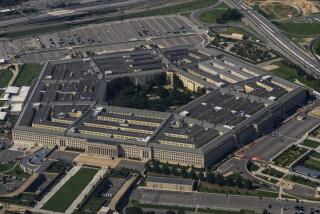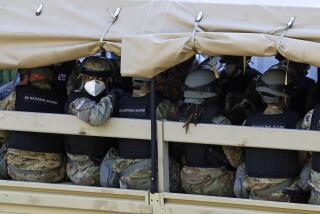U.S. special forces commander seeks to expand operations
WASHINGTON â A top U.S. commander is seeking authority to expand clandestine operations against militants and insurgencies around the globe, a sign of shifting Pentagon tactics and priorities after a grueling decade of large-scale wars.
Adm. William H. McRaven, a Navy SEAL and commander of the raid that killed Osama bin Laden, has developed plans that would provide far-reaching new powers to make special operations units âthe force of choiceâ against âemerging threatsâ over the next decade, internal Defense Department documents show.
Americaâs secret military forces have grown dramatically over the last decade as the Pentagon and the U.S. intelligence community have increasingly merged missions, including drone strikes and counter-terrorism operations.
But some Pentagon officials and outside experts warn that giving secret soldiers too much additional authority outside the normal chain of command might lead to abuses.
The little-known Special Operations Command, which McRaven heads from his headquarters in Tampa, Fla., oversees more than 60,000 military personnel and civilians.
The command includes Army Green Berets who specialize in training foreign military forces; Ranger light infantry units; Navy SEALs; Air Force squadrons flying drones and aerial gunships; and the Pentagonâs most elite combat units, Delta Force and the Naval Special Warfare Development Group, known as DEVGRU, which conducted the Bin Laden raid.
Congress has ordered the Pentagon to cut its budget growth, and President Obama has proposed reducing ground forces by 80,000 soldiers and 20,000 Marines. The White House has proposed increasing the 2013 Pentagon budget in only two areas: putting more forces in the western Pacific to counterChinaâs growing clout, and expanding special operations.
McRavenâs ideas, outlined in draft plans obtained by The Times, provide the first unclassified blueprint of how the Pentagon would achieve that goal.
âWe are in a generational struggle,â McRaven says in a draft paper circulating at the Pentagon. âFor the foreseeable future, the United States will have to deal with various manifestations of inflamed violent extremism. In order to conduct sustained operations around the globe, our special operations forces must adapt.â
His proposals parallel Obamaâs preference for using SEALs and other secretive forces, using remotely piloted Predator drones to launch missile strikes, and other unconventional tactics whenever possible, an approach the White House endorsed in a new defense strategy early this year.
But the draft plans appear to challenge assertions by Obama administration officials that the threat from Al Qaeda and other terrorist groups has significantly diminished after a decade of unrelenting pressure by America and its allies.
âNon-state actors, such as [Al Qaeda], will increasingly threaten our national security,â notes an unsigned staff memo attached to the documents. âThey will establish bases in places not under sovereign control. Moving easily across political boundaries and merging with indigenous populations, these non-state actors will seek to exploit our vulnerabilities.â
The draft plans do not specify where special operations would be increased, but officers and officials familiar with Pentagon thinking say it probably would include remote and chaotic areas of the Middle East, such as Yemen, parts of northern Africa stretching from Somalia to Nigeria and the Maghreb, and to a lesser extent, parts of Asia and Latin America.
If the plan is adopted, McRaven would be given additional authority to move special operations units quickly from country to country, to train foreign military units and to maintain a continual presence in parts of the globe where militants and terrorism networks are deemed a threat to U.S. interests.
Special operations forces already are deployed in at least 71 countries, although most are involved in training.
Some current and former officers worry that such broad authority could lead to special operations teams carrying out unilateral raids or training proxy military forces without the knowledge of other U.S. commanders, diplomats or civilian officials at the Pentagon.
âItâs a terrible idea,â said a recently retired four-star commander who agreed to discuss the proposal in return for anonymity. Special operations units âare wonderful, but they are focused on grabbing a terrorist or some other mission of the moment, and they donât want to be slowed down by anything.â
McRavenâs aides insist that the elite teams would remain under the direct day-to-day control of Pentagon regional commanders once deployed. But under his plan, McRaven would have greater authority to move forces and resources instead of merely responding to requests from regional commanders.
âWho better to say where special operations forces should be than the commander of Special Operations Command, with years of experience behind him?â asked one aide, defending the plan.
Currently, U.S. commanders responsible for each region of the world, or theater commanders, largely control how many special operations troops are sent to their areas and what missions they undertake. In the Middle East, for instance, such decisions now rest with Gen. James Mattis, the head of Central Command, and with Gen. John Allen, the top commander in Afghanistan.
McRavenâs blueprint is still in the planning stages. He is scheduled to brief Gen. Martin Dempsey, chairman of the Joint Chiefs of Staff, and civilian officials at the Pentagon on the plan in the next month, according to several senior officers.
It was Dempsey who requested that McRaven develop options âfor the future of [special operations forces] based on the lessons of the past 10 years of war and on the principles as outlined in our new defense strategy,â according to Col. Dave Lapan, a spokesman for Dempsey.
In a draft âCommanderâs Estimateâ that is part of the documents, McRavenâs staff wrote that Special Operations Command ârequires authorities that fully enable global ⌠operations.â
The plan faces âmajor bureaucratic obstacles to obtain the authoritiesâ to expand Special Operations Command, the Commanderâs Estimate acknowledges. Not only the geographic commanders but the Pentagonâs powerful Joint Staff, which plays a central role in recommending where and when special forces units will be deployed, are likely to have reservations, several officers said.
McRaven may be hoping in part on pushing the plan through with support from Obama.
The plan also calls for creating special operations âcoordinating centersâ around the world that would work with U.S. embassies, friendly governments and intelligence agencies to identify threats, the documents say.
McRavenâ aides played down the idea that the additional powers are aimed at increasing unilateral raids against suspected terrorists, arguing that the real aim is to gather intelligence and build the capabilities of foreign allies to defeat terrorist networks.
More to Read
Sign up for Essential California
The most important California stories and recommendations in your inbox every morning.
You may occasionally receive promotional content from the Los Angeles Times.











